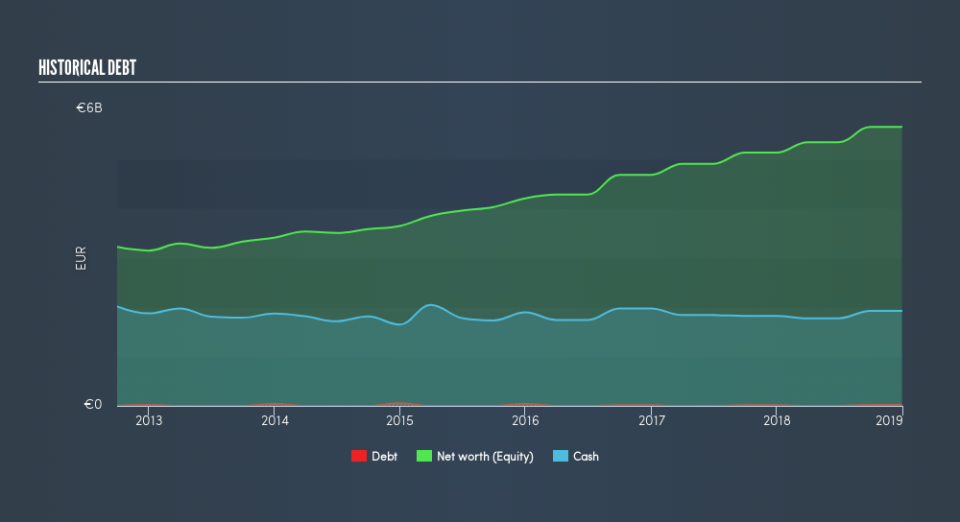These 4 Measures Indicate That Beiersdorf (ETR:BEI) Is Using Debt Reasonably Well

Warren Buffett famously said, 'Volatility is far from synonymous with risk.' When we think about how risky a company is, we always like to look at its use of debt, since debt overload can lead to ruin. Importantly, Beiersdorf Aktiengesellschaft (ETR:BEI) does carry debt. But the real question is whether this debt is making the company risky.
When Is Debt Dangerous?
Debt and other liabilities become risky for a business when it cannot easily fulfill those obligations, either with free cash flow or by raising capital at an attractive price. Part and parcel of capitalism is the process of 'creative destruction' where failed businesses are mercilessly liquidated by their bankers. However, a more frequent (but still costly) occurrence is where a company must issue shares at bargain-basement prices, permanently diluting shareholders, just to shore up its balance sheet. Of course, plenty of companies use debt to fund growth, without any negative consequences. When we examine debt levels, we first consider both cash and debt levels, together.
Check out our latest analysis for Beiersdorf
What Is Beiersdorf's Net Debt?
As you can see below, at the end of December 2018, Beiersdorf had €18.0m of debt, up from €14.0m a year ago. Click the image for more detail. But on the other hand it also has €1.92b in cash, leading to a €1.91b net cash position.
A Look At Beiersdorf's Liabilities
We can see from the most recent balance sheet that Beiersdorf had liabilities of €2.35b falling due within a year, and liabilities of €874.0m due beyond that. On the other hand, it had cash of €1.92b and €1.50b worth of receivables due within a year. So it can boast €202.0m more liquid assets than total liabilities.
Having regard to Beiersdorf's size, it seems that its liquid assets are well balanced with its total liabilities. So while it's hard to imagine that the €24.3b company is struggling for cash, we still think it's worth monitoring its balance sheet. Simply put, the fact that Beiersdorf has more cash than debt is arguably a good indication that it can manage its debt safely.
While Beiersdorf doesn't seem to have gained much on the EBIT line, at least earnings remain stable for now. The balance sheet is clearly the area to focus on when you are analysing debt. But ultimately the future profitability of the business will decide if Beiersdorf can strengthen its balance sheet over time. So if you want to see what the professionals think, you might find this free report on analyst profit forecasts to be interesting.
Finally, a business needs free cash flow to pay off debt; accounting profits just don't cut it. While Beiersdorf has net cash on its balance sheet, it's still worth taking a look at its ability to convert earnings before interest and tax (EBIT) to free cash flow, to help us understand how quickly it is building (or eroding) that cash balance. During the last three years, Beiersdorf produced sturdy free cash flow equating to 63% of its EBIT, about what we'd expect. This free cash flow puts the company in a good position to pay down debt, when appropriate.
Summing up
While we empathize with investors who find debt concerning, you should keep in mind that Beiersdorf has net cash of €1.9b, as well as more liquid assets than liabilities. So is Beiersdorf's debt a risk? It doesn't seem so to us. Above most other metrics, we think its important to track how fast earnings per share is growing, if at all. If you've also come to that realization, you're in luck, because today you can view this interactive graph of Beiersdorf's earnings per share history for free.
Of course, if you're the type of investor who prefers buying stocks without the burden of debt, then don't hesitate to discover our exclusive list of net cash growth stocks, today.
We aim to bring you long-term focused research analysis driven by fundamental data. Note that our analysis may not factor in the latest price-sensitive company announcements or qualitative material.
If you spot an error that warrants correction, please contact the editor at editorial-team@simplywallst.com. This article by Simply Wall St is general in nature. It does not constitute a recommendation to buy or sell any stock, and does not take account of your objectives, or your financial situation. Simply Wall St has no position in the stocks mentioned. Thank you for reading.

 Yahoo Finance
Yahoo Finance 
